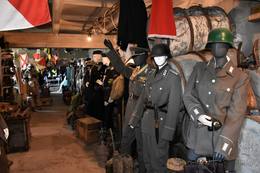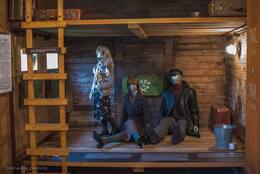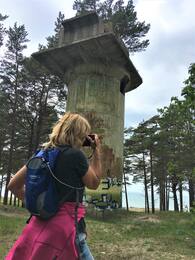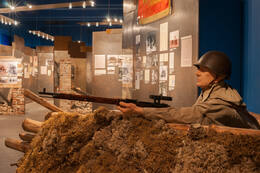Hitlerio-Stalino/Molotovo-Ribentropo paktas
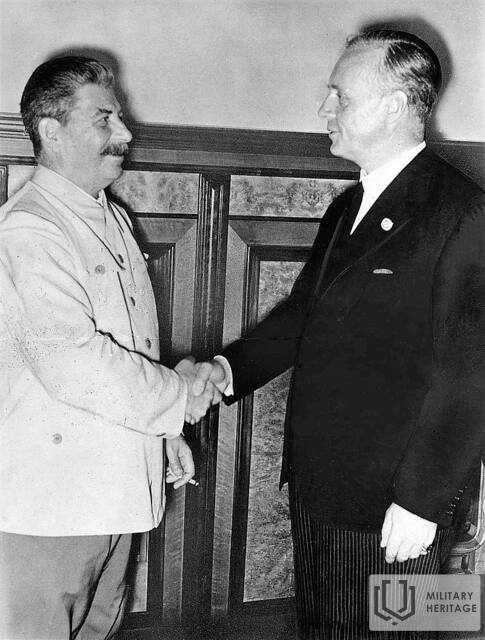
Rugpjūčio 23-ioji paskelbta stalinizmo ir nacizmo aukų Europoje atminimo diena, nes šią dieną buvo pasirašytas Molotovo-Ribentropo paktas, pakeitęs pasaulio sceną ir istoriją. 1939 m. rugpjūčio 23 d. Sovietų Socialistinių Respublikų Sąjunga (SSRS, Sovietų Sąjunga) ir Vokietija pasirašė „Abipusio nepuolimo paktą“, žinomą kaip Molotovo-Ribentropo paktas. Kartu su Molotovo-Ribentropo paktu buvo pasirašytas ir „Slaptasis papildomas protokolas“, kuriuo šalys susitarė pasidalyti abipusių interesų sferas Rytų Europoje. Suomija, Estija, Latvija, dalis Lietuvos ir Besarabija turėjo atitekti SSRS, o pietinė Lietuvos dalis – Vokietijos įtakos sferai, kuri vėliau buvo perskirta SSRS.
Rugpjūčio 23 d. slaptajame papildomame protokole buvo minima, kad Latvija ir kitos Baltijos valstybės patirs „teritorinius-politinius pertvarkymus“. Šių dalykų supratimas aiškiai išryškėja iš J. Stalino žodžių, kuriuos jis pasakė likus kelioms dienoms iki rugsėjo 28 d. protokolo pasirašymo: „Vokietija suteikia mums visišką veiksmų laisvę Baltijos valstybėse“. Pažymėtina, kad 1939 m. rugsėjo 28 d. SSRS sudarė savitarpio pagalbos sutartį su Estija, o 1939 m. spalio 5 ir 10 d. – atitinkamai su Latvija ir Lietuva. Vėliau, 1939 m. spalio 25 d., J. Stalinas, kalbėdamasis su Kominterno vykdomojo komiteto generaliniu sekretoriumi G. Dimitrovu, pareiškė: „Sovietų Sąjungos vadovybė mano, kad savitarpio pagalbos paktais su Estija, Latvija ir Lietuva buvo rasta forma, kuri leis Sovietų Sąjungai į savo orbitą įtraukti nemažai šalių. Tik kol kas būtina griežtai laikytis jų vidaus režimo ir suvereniteto, nesiekiant sovietizacijos. Ateis laikas, kai jos pačios [SSRS] tai padarys.“
Atėjo laikas 1940 m. birželio 16 d., kai SSRS paskelbė Latvijai ultimatumą. Vėliau Latvijos teritorija buvo okupuota ir aneksuota, o gyventojai patyrė žiaurias represijas: masines žudynes, nepagrįstą įkalinimą ir kankinimą, tremtį tūkstančius kilometrų nuo tėvynės, priverstinį darbą ir priverstinį gyvenimą nežmoniškomis sąlygomis. Šie įvykiai radikaliai pakeitė Latvijos istoriją ir nukreipė Latvijos vystymąsi sunkiu keliu.
SSRS Liaudies deputatų suvažiavimas 1989 m. gruodžio 24 d. nutarime „Dėl 1939 m. SSRS ir Vokietijos nepuolimo pakto politinio ir teisinio įvertinimo“ konstatavo, kad su Vokietija sudaryti slaptieji protokolai yra teisiškai nepagrįsti ir negaliojantys nuo jų pasirašymo momento. Panašias išvadas 1989 m. rugsėjo 1 d. deklaracijoje padarė ir Vokietija. Vokietija slaptuosius papildomus protokolus apibūdino kaip gėdingą išpuolį prieš tarptautinę teisę. Ji pareiškė, kad protokolai negali pateisinti Vokietijos ir SSRS padarytų tarptautinės teisės pažeidimų. Savo ruožtu Latvijos Sovietų Socialistinės Respublikos Aukščiausioji Taryba 1990 m. gegužės 4 d. deklaracijoje „Dėl Latvijos Respublikos nepriklausomybės atkūrimo“ pripažino Molotovo-Ribentropo paktą neteisėtu.
Daugiau informacijos šaltinių
Sajadova, V. Molotovo-Ribentropo paktas ir jo įtaka Latvijos valstybės suverenitetui. Prieinama: http://okupacijasmuzejs.lv/lv/latvijas-okupacijas-vesture/1-padomju-okupacija/molotovaribentropa-pakts-un-ta-ietekme-uz-latvijas-valsts-suverenitati [žiūrėta 2021-05-06].
Susijusi laiko juosta
Susijusios vietos
Privati karinė kolekcija Mundigciems mieste
Privati karinė kolekcija Mundigciemse. Aivaras Ormanis jau daugelį metų kolekcionuoja istorinius objektus – karines uniformas, uniformas, maskuojamuosius drabužius, ryšio priemones, namų apyvokos daiktus, apsaugos priemones iš įvairių laikotarpių ir šalių, datuojamus Antruoju pasauliniu karu, sovietų armija ir nepriklausomos Latvijos atkūrimu.
Šiuo metu kolekcija nėra gerai prižiūrima, o eksponatai saugomi buvusiame kolūkio tvarte.
Trėmimams naudotas galvijinis vagonas – muziejus Skrundos geležinkelio stotyje
1941 m. birželio ir 1949 m. kovo mėn. trėmimams atminti Skrundos geležinkelio stotyje pastatytas atminimo akmuo ir keturašis vagonas, kuris taip pat tarnauja kaip trėmimams skirtas muziejus. Tai pirmasis vagono tipo muziejus Latvijoje, kuriame nuolat eksponuojamos iš Skrundos stoties ištremtų žmonių nuotraukos, laiškai, atsiminimai, dokumentai ir įvairūs daiktai. Skrundos stotis buvo tremtinių surinkimo vieta ir viena iš trijų regiono stočių, į kurią buvo atvežti žmonės iš Skrundos ir Kuldygos apylinkių. 1941 m. iš čia į Krasnojarsko kraštą Sibire buvo ištremta pirmojo atkurtos Latvijos Respublikos prezidento Gunčio Ulmanio šeima.
Deportacijų pagalba sovietai susidorojo su nacionalinių partizanų šalininkais ir tuo pačiu metu baugino likusius kaimo gyventojus, versdami juos stoti į kolūkius.
Paviluosto vietos istorijos muziejaus ekspozicija
Paviluostos kraštotyros muziejuje veikianti paroda, pavadinta „Paviluosta, uždara teritorija“, pasakoja apie kasdienį gyvenimą Paviluostos mieste sovietinės okupacijos metu; konkrečiai apie vykdomąją valdžią, pasienio zoną, žvejų kolūkį, kultūrinę ir socialinę veiklą. Be nuolatinės ekspozicijos, yra interaktyvi ir emociškai turtinga skaitmeninė ekspozicija dviem kalbomis bei audiovizualinė instaliacija, kurioje rodomas filmas apie Paviluostą.
Muziejuje taip pat atidaryta nauja paroda pavadinimu „Paviluostos auksiniai smėlio grūdeliai“. Skaitmeninėje instaliacijoje pristatomi seni įvykiai, Paviluostos įkūrimo istorija ir svarbiausi įvykiai nuo 1918 m. iki šių dienų. Karinis paveldas yra pagrindinis Nepriklausomybės karo skyriaus, kuriame pasakojama apie Latvijos laisvės kovotojus ir sovietinės okupacijos laikotarpį, akcentas.
23-iosios Kranto baterijos pirmasis tolimatis (1941 m.)
Tolimačiai (datuojami 1941 m.) yra kopos pušyse, vos už 10 m nuo kito bokšto, pastatyto 1954 m. Kranto baterijos 1-oji ir 2-oji patrankų pozicijos yra pajūryje ir iš dalies eroduotos, o 4-oji patrankų pozicija geriausiai matoma kopose. Pabūklus aptarnavusių personalo gelžbetoninis bunkeris dabar nuplautas bangų ir turi išplautus pamatus, pasvirusius ir pasvirusius į jūrą.
Liepojos tvirtovės 2-oji baterija buvo planuojama statyti toliau nuo kranto linijos ir apsaugoti aukštu pylimu. Baterijos ginkluotė turėjo būti 16 11 colių (280 mm) minosvaidžių, pagamintų 1877 m. modelio. Minosvaidžiai turėjo taikyti stačias trajektorijas ir nereikalavo tiesioginio taikymo.
Pagal 1939 m. spalio 5 d. pasirašytą Latvijos Respublikos ir SSRS „bazių susitarimą“, Kuržemėje turėjo būti dislokuotas beveik 25 000 Raudonosios armijos ir Baltijos karinio jūrų laivyno karių kontingentas. Iki 1941 m. kovo mėn. Latvijoje, Irbės įlankos, Saremos ir Liepojos gynybos sektoriuose, buvo įkurtos Baltijos šalių karinio jūrų laivyno bazės, kurias sudarė pakrantės gynybos baterijos.
Liepojos pakrantės gynybos sektorių sudarė 208-oji artilerijos divizija su dviem 130 mm B-13 patrankų baterijomis (Nr. 23 ir Nr. 27) ir viena 180 mm bėginių patrankų baterija. 23-iosios baterijos statyba prasidėjo 1939 m. lapkritį ir buvo baigta 1941 m. gegužės 17 d., iš dalies panaudojant Liepojos tvirtovės 2-osios baterijos gelžbetoninius įtvirtinimus. 23-iąją bateriją sudarė keturios gelžbetoninės patrankų pozicijos pakrantėje, vadovavimo postas ir stebėjimo (atstumo matavimo) bokštas kopų miške. Atstumo matavimo pozicijos buvo išdėstytos gelžbetoniniuose bokštuose, siekiant užtikrinti geresnį matomumą ir kartu išlaikant paslėptą vietą pušyne.
Po Antrojo pasaulinio karo 23-ioji baterija buvo pervadinta į 636-ąją ir ginkluota tais pačiais 130 mm B-13 pabūklais, o 1954 m., greta 1941 m. bokšto, ugnies valdymui buvo pastatytas naujas šaudymo bokštas. 1963 m. buvo išardytos visos Liepojos pakrantės gynybos pabūklai.
Atkūrus Latvijos nepriklausomybę, 2-osios baterijos rajonas priklauso Gynybos ministerijai.
Liepojos pakrantės gynybos baterija 23
Baterija yra tarp Tobago ir Marine gatvių, jūros link.
Pagal 1939 m. spalio 5 d. pasirašytą Latvijos Respublikos ir SSRS „bazių sutartį“, Kuržemėje turėjo būti dislokuotas beveik 25 000 Raudonosios armijos ir Baltijos karių kontingentas. Iki 1941 m. kovo mėn. Latvijoje, Irbės įlankos, Saremos ir Liepojos gynybos sektoriuose, buvo įkurtos Baltijos šalių karinio jūrų laivyno bazės, kurias sudarė pakrantės gynybos baterijos.
Liepojos pakrantės gynybos sektorių sudarė 208-oji artilerijos divizija su dviem 130 mm B-13 patrankų baterijomis (Nr. 23 ir Nr. 27) ir viena 180 mm bėginių patrankų baterija. 23-iosios baterijos statyba prasidėjo 1939 m. lapkritį ir buvo baigta 1941 m. gegužės 17 d., iš dalies panaudojant Liepojos tvirtovės 2-osios baterijos gelžbetoninius įtvirtinimus. 23-iąją bateriją sudarė keturios gelžbetoninės patrankų pozicijos pakrantėje, vadovavimo postas ir stebėjimo (atstumo matavimo) bokštas kopų miške. Atstumo matavimo pozicijos buvo išdėstytos gelžbetoniniuose bokštuose, siekiant užtikrinti geresnį matomumą ir kartu išlaikant paslėptą vietą pušyne.
1 ir 2 patrankų pozicijos yra pajūryje ir iš dalies eroduotos, o 4 patrankų pozicija geriausiai matoma kopose. 23-iąją bateriją 1941 m. birželio 27 d. susprogdino sovietų kareiviai, traukiantis iš Liepojos.
Po Antrojo pasaulinio karo 23-ioji baterija buvo pervadinta į 636-ąją ir ginkluota tais pačiais 130 mm B-13 pabūklais, tačiau 1954 m., greta 1941 m. bokšto, ugnies valdymui buvo pastatytas naujas šaudymo bokštas. 1963 m. buvo išardytos visos Liepojos pakrantės gynybos pabūklai.
Atkūrus Latvijos nepriklausomybę, 2-osios baterijos rajonas priklauso Gynybos ministerijai.
Du bokštai yra labai arti vienas kito – vos 10 m atstumu. Keturios pabūklų pozicijos buvo išdėstytos dešinėje nuo abiejų bokštų, iš tikrųjų pakrantėje. Pabūklus aptarnavusių personalo gelžbetoninis bunkeris dabar nuplaunamas bangų ir turi išplautus pamatus, pasvirusius ir pasvirusius į jūrą.
Latvijos karo muziejus
Latvijos karo muziejus yra įsikūręs senamiestyje, netoli Laisvės paminklo, istoriniame gynybos pastate, vadinamame „Parako bokštu“. Muziejuje yra 11 eksponatų. Čia eksponuojami įvairūs ginklai, dokumentai, uniformos, apdovanojimai, ženkleliai ir kiti daiktai, pasakojantys apie kasdienį kareivio gyvenimą kare. Latvijos karo muziejus yra vienas seniausių muziejų Latvijoje. Jo ištakos siekia Pirmąjį pasaulinį karą. Muziejaus kolekciją daugiausia sudarė asmeniniai kareivių daiktai arba mūšio laukuose rasti daiktai. Latvijai atgavus nepriklausomybę, pagrindinis muziejaus tikslas tapo sukurti ekspoziciją apie Latvijos karo istoriją ir aktyvų gyventojų vaidmenį saugant savo žemę. 1937 m. muziejus buvo išplėstas ir techniškai buvo vienas moderniausių tuo metu Europoje. Parako bokštas buvo vienas iš Rygos įtvirtinimų bokštų. Kai kurie įrodymai siekia 1330 m., kai jis buvo minimas kaip „Smėlio bokštas“. Bokštas buvo sugriautas 1621 m., kai Rygą apgulė Švedijos armija. Tačiau 1650 m. buvo pastatytas naujas bokštas parakui ir ginklams laikyti. Nugriovus miesto įtvirtinimus, Parako bokštas išlieka vienu svarbiausių Rygos gynybos sistemos įrodymų.
Molotovo gynybinės linijos bunkeris
Šalia žvyrkelio Pikteikiai – Žalsėnai, puikiai automobiliu pasiekiamoje vietoje yra išlikęs Molotovo gynybinės linijos bunkeris.
Molotovo linija yra 1940–1941 m. SSRS paskubomis pradėta statyti fortifikacinė gynybinė linija, kuri ėjo per 1939–1940 m. SSRS okupuotas ir aneksuotas Lietuvos, Lenkijos, Baltarusijos ir Ukrainos teritorijas. Molotovo linija Lietuvos teritorijoje buvo suskirstyta į Telšių, Šiaulių, Kauno ir Alytaus įtvirtinimų rajonus, o visos linijos ilgis Lietuvos teritorijoje – 328 km (nuo Palangos iki Kalvarijos). Lietuvoje esančioje linijos atkarpoje buvo pradėti statyti 101 betoniniai bunkeriai, tačiau nei vienas iš jų nebuvo baigtas ir pilnai įrengtas iki Vokietijos – Rusijos karo pradžios 1941 m. birželio mėnesį. Nors Molotovo linija buvo skirta gynybai nuo Vokietijos kariuomenės puolimo, tačiau Vokietijos ir Rusijos karo metu ji planuotos funkcijos neatliko.
Molotovo gynybinės linijos bunkeris
Laukuose prie Endriejavo galima susipažinti su išlikusiu ir nebaigtu statyti Molotovo linijos bunkeriu.
Molotovo linija yra 1940–1941 m. SSRS paskubomis pradėta statyti fortifikacinė gynybinė linija, kuri ėjo per 1939–1940 m. SSRS okupuotas ir aneksuotas Lietuvos, Lenkijos, Baltarusijos ir Ukrainos teritorijas. Molotovo linija Lietuvos teritorijoje buvo suskirstyta į Telšių, Šiaulių, Kauno ir Alytaus įtvirtinimų rajonus, o visos linijos ilgis Lietuvos teritorijoje – 328 km. (nuo Palangos iki Kalvarijos). Lietuvoje esančioje linijos atkarpoje buvo pradėti statyti 101 betoniniai bunkeriai, tačiau nei vienas iš jų nebuvo baigtas ir pilnai įrengtas iki Vokietijos – Rusijos karo pradžios 1941 m. birželio mėnesį. Nors Molotovo linija buvo skirta gynybai nuo Vokietijos kariuomenės puolimo, tačiau Vokietijos ir Rusijos karo metu ji planuotos funkcijos neatliko.
Susijusi istorija
Dėl Latvijos okupacijos
1940 m. nepriklausomos Latvijos valstybės egzistavimą nutraukė Sovietų Sąjungos okupacija ir aneksija, arba inkorporacija, į Sovietų Socialistinių Respublikų Sąjungą (SSRS).
Dingę vokiečių kareiviai Kuršo mūšyje - Karlas Grimmas
Vokiečių armijos grupės „Šiaurė“, vėliau pervadintos „Kurlandu“ per Kuršo apgultį, įrašuose vis dar nėra aiškios informacijos apie maždaug 50 000 vokiečių kareivių. Šie kareiviai yra įtraukti į dingusiųjų sąrašą. Net ir šiandien šių kareivių giminaičiai bando rasti savo giminaičių ir protėvių pėdsakų Kurše – tiek dokumentinių, tiek fizinių. Viena iš tokių istorijų – Karlo Grimmo, vokiečių kareivio iš Švabijos (istorinio regiono pietvakarių Vokietijoje, prie Reino ir Dunojaus upių ištakų), kurio karo karjera nutrūko 1944 m. spalio 27 d. Krūmų namuose netoli Vainodės (5 km į šiaurės vakarus nuo Vainodės, Latvijoje).




